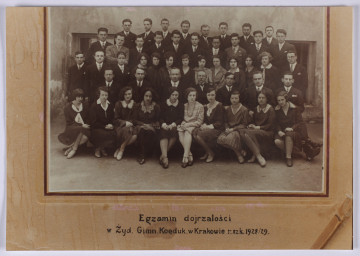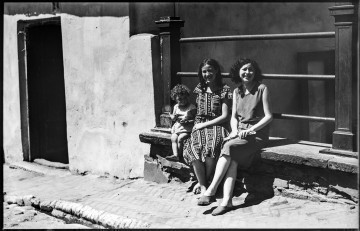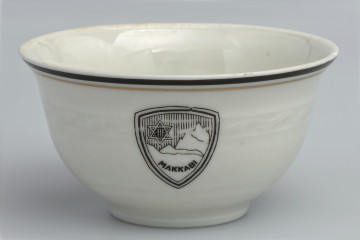
The photograph of the graduates of the Jewish Coeducational Middle School in Kraków
1928 — 1929
Museum of the history of Polish Jews
Part of the collection: The family memorabilia of Justmans and Włodawers
From 5 October 1937, segregation was in force at the University of Warsaw. It manifested itself mainly in forcing Jewish students to take designated places in lecture halls, hence the common name of this discriminatory, anti-Semitic regulation: bench ghetto. Jews were also forbidden to join the same student clubs as Christian students. However, as one can guess looking at this card from the previous academic year, the same rule had applied (at least in some clubs) even before the official adoption of the segregating ordinances. Jewish students, therefore, founded their own student bodies.
The university certificate, mentioned by Paulina Włodawer in her diary, helped her find work as a teacher in Lutsk and later as a nurse in Asino. She may have carried also the membership card on her throughout the war as a makeshift proof of education (or simply a photo ID).
Paulina Włodawer completed her studies just before the war, but did not receive a diploma before September 1939. In her diary (MPOLIN-A4.1.1, entry of 17 September 1980) she recalled: I took my final exam in July, after Professor Białaszewicz returned from Italy, but I postponed getting my diploma until later, for two reasons: first of all - I very much wanted to go to Zakopane for a vacation, and secondly - receiving the diploma involved a lot of formalities and a lot of expenses, so it was a waste of both time and money (which I did not have in excess). So now [i.e. in September 1939] something had to be done about it. I went to Krakowskie [Przedmieście], to the university. It turned out to be partially broken, deserted and closed for good. There were also others like me there, but there was no one to talk to. The only reasonable thing I could do was see what was happening at Wawelska Street. The building of the Radium Institute, which housed the so-called physiological chemistry, was fortunately still there. I had spent several years of my life there, having a half-day, all-day and graduation laboratory classes, so it was almost my home and I was glad to see the familiar walls. In the laboratory I encountered Włodzimierz Niemierka (of course!) and even Mrs. Stella, whom, at the time, I knew just a little, because she worked elsewhere. Together with the janitor, they tried to clean up the building as it was hit by a few bullets [...]. So Niemierko wrote me a long certificate of my thesis, exams and diploma, that concluded my studies, he took it for signature to Professor Białaszewicz (who was in a bad condition, depressed and sick). There was even a seal and this piece of paper accompanied me in the following years and on its basis I received my diploma at another stage of my life.''
Thanks to the certificate, among the others, including membership card, she received work as a teacher in Lutsk as well as a nurse in Asino. However, it is most likely that she brought the card with her as a kind of memento of discrimination. Facing any subsequent manifestations of discrimination or persecution, she reacted in a very decisive manner: in September 1939, she decided to flee to the East immediately after the first incident which affected a member of her family (her husband Artur Włodawer; his head was shaved by Germans playing their typical game of stopping and harassing random Jews in the streets), and during the events of March 1968, she quickly filed departure documents with her husband and son.
Przemysław Kaniecki
Author / creator
Dimensions
cały obiekt:
Object type
document
Technique
handwriting, printing
Material
paper
Creation time / dating
Creation / finding place
Owner
POLIN Museum of the History of Polish Jews
Identification number
Location / status

1928 — 1929
Museum of the history of Polish Jews

1931
National Museum in Lublin

1930 — 1939
Museum of the history of Polish Jews
DISCOVER this TOPIC
Museum of King Jan III's Palace at Wilanów
DISCOVER this PATH
Educational path